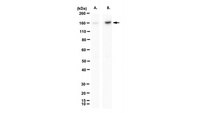MABE1925-25UG Sigma-AldrichAnti-acetyl SMC3 (Lys105/106) Antibody, clone 209f/A7
Anti-acetyl SMC3 (Lys105/106), clone 209f/A7, Cat. No. MABE1925, is a mouse monoclonal antibody that detects acetylated Structural maintenance of chromosomes protein 3 (SMC3) and is tested for use in ChIP-seq, Immunofluorescence, and Western Blotting.
More>> Anti-acetyl SMC3 (Lys105/106), clone 209f/A7, Cat. No. MABE1925, is a mouse monoclonal antibody that detects acetylated Structural maintenance of chromosomes protein 3 (SMC3) and is tested for use in ChIP-seq, Immunofluorescence, and Western Blotting. Less<<Productos recomendados
Descripción
| Replacement Information |
|---|
| References |
|---|
| Product Information | |
|---|---|
| Format | Purified |
| Presentation | Purified mouse monoclonal antibody IgG1 in buffer containing 0.1 M Tris-Glycine (pH 7.4), 150 mM NaCl with 0.05% sodium azide. |
| Quality Level | MQ200 |
| Physicochemical Information |
|---|
| Dimensions |
|---|
| Materials Information |
|---|
| Toxicological Information |
|---|
| Safety Information according to GHS |
|---|
| Safety Information |
|---|
| Storage and Shipping Information | |
|---|---|
| Storage Conditions | Stable for 1 year at +2°C to +8°C from date of receipt. |
| Packaging Information | |
|---|---|
| Material Size | 25 μg |
| Transport Information |
|---|
| Supplemental Information |
|---|
| Specifications |
|---|
| Global Trade Item Number | |
|---|---|
| Número de referencia | GTIN |
| MABE1925-25UG | 04065266020694 |
Documentation
Anti-acetyl SMC3 (Lys105/106) Antibody, clone 209f/A7 Ficha datos de seguridad (MSDS)
| Título |
|---|
Anti-acetyl SMC3 (Lys105/106) Antibody, clone 209f/A7 Certificados de análisis
| Cargo | Número de lote |
|---|---|
| Anti-acetyl SMC3 (Lys105/106), clone 209f/A7 - 4110921 | 4110921 |
| Anti-acetyl SMC3 (Lys105/106), clone 209f/A7 - 4222554 | 4222554 |
| Anti-acetyl SMC3 (Lys105/106), clone 209f/A7 - Q3666258 | Q3666258 |







